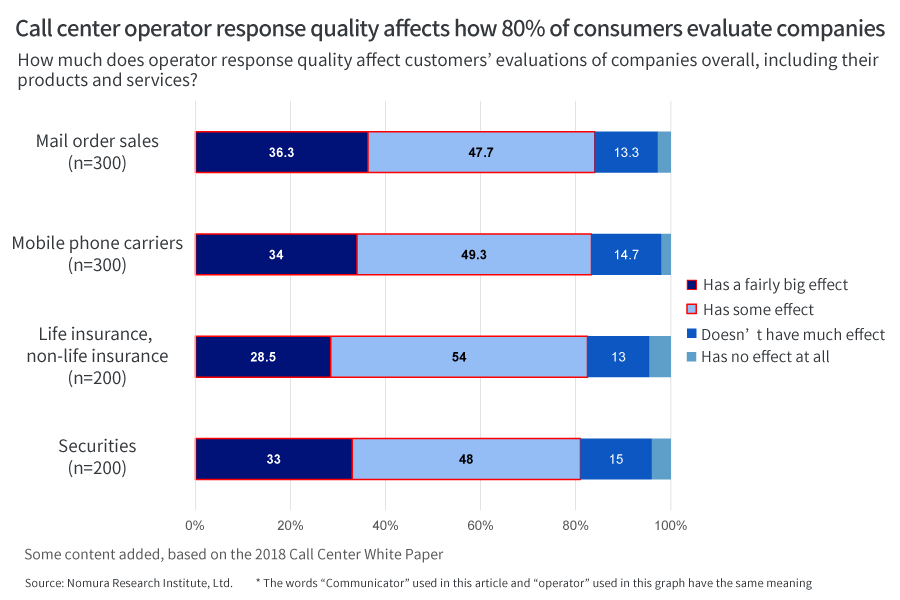
The Challenges and Importance of Contact Centers as “Corporate Faces” in the DX Era: Changes to Contact Centers Brought on by AI (Part 1)
With digitalization, goods and services that used to be sold in real stores have increasingly come to be sold at online shops or otherwise over networks. As face-to-face exchanges with customers become fewer, contact centers handling customer interactions have been taking on tremendous importance, yet many companies are struggling to meet this challenge. What is required from contact centers in the DX era? And what are the possibilities? Over three installments, we will be addressing these questions with a focus on AI. For this first entry, we asked NRI’s Haruhiko Kanda—who visits 50 or more Japanese companies a year and is familiar with contact center conditions—about any clues he might have for solving these problems.
IT literacy and psychological factors as barriers to securing human resources
--- Are there any problems you see that corporate contact centers have in common?
Yes, there’s the worsening problem of labor shortages in Japan. In recent years, the number of products and services being handled by individual companies has been on the rise, and customer bases have been growing as well. Along with this, the nature of inquiries received has grown more diverse, and communicators are required to have a greater body of knowledge. What’s more, since around 2000 the use of IT at contact centers had become more advanced, and workers must handle PC operations in addition to providing phone support. So, the issues here are the requisite knowledge about increasing numbers of products and services, skills for responding to a wider range of inquiries, and IT literacy. Companies have to secure and train human resources who possess these three attributes, but many companies are struggling to do this now.
Contact center jobs essentially are supposed to be a worthwhile type of work, in that you provide support to customers who are having trouble, satisfy those customers, and make them into fans of your company. But the required knowledge, response capabilities, and IT literacy have become high psychological hurdles, high enough to eclipse this sense of the work being worthwhile.
--- What kinds of measures have been taken to deal with these labor shortages?
I’ve seen companies making efforts like raising wages at hiring time, concentrating on acquiring new communicators by lowering hiring standards, and enhancing the productivity of communicators already on staff. As far as enhancing productivity is concerned, attention tends to get paid to ensuring thorough management, for instance by shortening the lengths of responding times, hold times, and recording times, while increasing the number of cases handled per hour. However, if a company tries to shorten these times excessively, it can experience drops in response quality or employee satisfaction, so this can backfire.
The quality of contact centers has a major effect on company evaluations
--- It has been pointed out that the quality of contact centers’ responses is directly tied to company evaluations.
According to the “2018 Call Center White Paper”, although there are differences among industries and business types, 80% of Japanese consumers said that communicator responses affect their evaluations of companies. In addition, when customers feel dissatisfied with a service or a product, it tends to lead customer defection. Especially with mail order sales, which is an area where communicators are at the forefront, 40% of consumers who feel dissatisfied will leave. Even when it comes to the kinds of businesses where it’s difficult to switch providers, like mobile phone carriers, insurance, or securities for instance, this is a major reason for customer defection. What’s more, it’s easy for disgruntled customers to share negative reviews, and in today’s day and age where SNS is everywhere, this has an impact on company image that can’t be ignored.
So, the reality is that while contact center quality is important, there are quite a few companies whose management has failed to recognize that trouble with hiring communicators has begun to cause problems for their operations.

--- What kinds of things are companies doing to solve this problem?
Now, the focus at contact centers is being put on efforts to assist communicators’ operations and knowledge using AI. More and more companies are becoming inclined to switch to AI for handling the task of recording the content of phone-based responses after the calls, with the AI recognizing the voice data from the call and automatically transcribing it. Also, functions for not merely making records but also summarizing the main points of the calls are becoming more robust.
The use of AI is also growing for presenting communicators with necessary information during calls to bolster their knowledge. There are even efforts being made that involve taking product names as keywords and then proactively displaying key questions and answers that are frequently asked about those products, as well as displaying points to be confirmed for more complicated inquiries, so that even inexperienced communicators have the help they need to promptly clarify the customer’s issues.
The degree of importance attached to contact centers is also directly correlated to business performance
--- Generally speaking, is the digitalization of contact centers seen as a priority issue?
It depends on the type of industry and business involved. Mail order business and other retailers that don’t have real stores, as well as financial institutions, for instance, are actively making investments. Things like the importance placed on the contact center within the company and the level of concern among the management tier also have an effect. In particular, there are companies where the management will periodically drop by the contact center, and will not only converse actively with the communicators there, but will also use voice recognition technology to observe how often customers express their appreciation, or do “undercover” inspections to check response quality, appropriately noting the efforts of the staff there and giving out commendations. These are the companies where digitalization is becoming more advanced, but beyond that, their business performance results also tend to be strong.
--- Are there any points that should be emphasized when it comes to promoting digitalization?
There are many companies that try to do PoC (proof-of-concept) right off the bat when they’re adopting AI for the first time, but in some cases that only leads them to spend more time or money and hampers their efficiency. As opposed to business operations for which there aren’t many examples, the areas at contact centers where AI can be applied are very concrete, and it can be used across the board without being limited to specific industries or business types. There are already a lot of AI programs that have experience and proven results for use at contact centers, and approaches for making these programs conform to your company’s situation can be effective for rapidly producing results.
In marketing, there are also companies that are focused on enhancing net sales using AI. But the key point here is that it’s precisely in this age—when multichannel and omnichannel setups have become quite common—that the response quality at contact centers is a vital issue. It’s important to reaffirm the contact center as a vital contact point with customers that serves as your “company’s face”, and to accurately understand the reality here.
We believe that NRI’s insights about consultations and R&D, which spans over 20 years, can help solve problems in the DX era involving contact centers as “corporate faces”.

Profile
-
Haruhiko KandaPortraits of Haruhiko Kanda
Group Manager
Digital Workplace AI Solution Business Department
Since joining NRI in 2002, Haruhiko has engaged in a number of data mining, text mining, and marketing research works. He proposed “Voice of the Customer Management”, which systematized VOC analysis methods, in 2007. He has subsequently worked on numerous projects concerning contact center knowledge management and big data use. Presently, he is engaged in developing and supporting use of various AI technologies, including the AI solution “TRAINA”, with the aim of increasing the value of and enhancing productivity at contact centers. He also studies new roles and functions of next-generation contact centers and challenges they face. He has appeared on numerous TV shows, including IT White Box on NHK Educational TV and World Business Satellite on TV Tokyo, and has delivered lectures and authored articles. He is an NRI-certified business analyst and holds a Ph.D. in business administration.
* Organization names and job titles may differ from the current version.